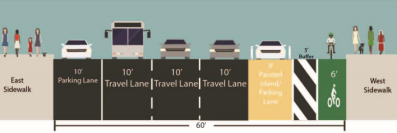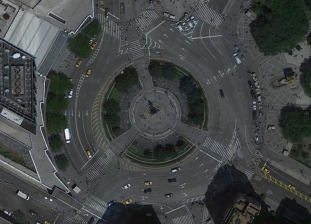Safer Bikeways Slated for Columbus Circle and Amsterdam Avenue

The bike network connecting Midtown and the Upper West Side is in line for significant upgrades. Last night, DOT presented plans for an extension of the Amsterdam Avenue bike lane from 72nd Street to 52nd Street [PDF], and for bikeway upgrades to Columbus Circle and the blocks of Eighth Avenue approaching it [PDF].
The Manhattan Community Board 4 transportation committee endorsed the projects unanimously, with some members asking DOT for safer design treatments at intersections.
The Eighth Avenue/Columbus Circle project would improve the northbound bike connection between 56th Street, where the existing Eighth Avenue bike lane loses physical protection, and Central Park West at 59th Street — as well as southbound bike trips through the circle to Broadway.
The Amsterdam Avenue project, meanwhile, would nearly double the length of the northbound protected bikeway that currently runs between 72nd and 110th streets.
On Eighth Avenue, DOT plans to extend the existing protected lane up to 59th Street, with two concrete pedestrian islands each at the intersections with 57th Street and 58th Street. At 57th Street, the only left turn in the short stretch, the agency will install a split phase signal, which allows cyclists and pedestrians to cross while left-turning motorists have the red light.

Approaching 59th Street, Eighth Avenue feeds into Columbus Circle, a treacherous five-lane mess where 54 people have been injured in crashes since 2009. DOT plan puts a green bike lane in the center of the circle, without physical barriers. Cyclists would follow pedestrian signals to cross into and out of the center ring.
On 10th Avenue/Amsterdam Avenue — the street name shifts at 59th Street — DOT plans to extend the protected bike lane design it installed between 72nd Street and 110th Street two years ago. A six-foot bike lane with a three-foot buffer will be protected by a parking lane, replacing one travel lane on the wide, one-way street. All pedestrian islands at intersections will be painted, however, and will lack the permanence of concrete.
Since 2012, two cyclists have been killed by drivers on this segment of 10th/Amsterdam, at 55th Street and 72nd Street. Motorists severely injured four pedestrians and eight cyclists in the project area in the same timeframe. The intersection with 72nd Street, the “bowtie” where Amsterdam and Broadway cross, is particularly dangerous: Since 2012, nine cyclists and two pedestrians have been injured, in addition to the cyclist fatality.
Passing through the bowtie, the bike lane will lose its parking protection. Between 70th Street and 71st Street, people on bikes will share a lane with turning motorists. North of 71st, the bike lane will run along the curb, adjacent to a bus-only turn lane, before connecting with the existing protected lane north of 72nd Street.

In CB 4, the new section of the 10th/Amsterdam bike lane crosses five left turn zones for motorists, only two of which will be get dedicated signal phases for cyclists. The rest will have mixing zones, where cyclists going straight have to jockey with left turning motorists. Additionally, none of the pedestrian islands will be raised, at least not initially, because DOT lacks the funds in its concrete budget. Instead, they’ll be fenced in by flexible delineators.
CB 4 members were not pleased with these shortcomings. CB 4 was one of the community boards that called on DOT to eliminate mixing zone intersections last year (DOT is expected set to release a study of other intersection designs for protected bike lanes later this summer). Board members also expressed concern that the painted pedestrian islands feel dangerous to stand in — and put people at risk of getting hit.
“For pedestrians it doesn’t feel safe to be on those pedestrian islands,” said committee co-chair Christine Berthet said.
Nevertheless, board members and other attendees lauded DOT for creating useful new links in the bike network, and the committee unanimously endorsed both projects.
“I bike with my toddler to Central Park. It’s my absolute favorite thing to do and I can get there protected the entire way, except for [Columbus Circle],” Charlie Todd told the DOT reps. “The circle, it’s a mess. I think this is a great start.”
The Columbus Circle and Amsterdam Avenue redesigns both overlap with Community Board 7, which requested protected bike lanes at the circle last year. DOT reps said last night they hope to implement these projects by the end of the year, but no specific timetable has been set.


